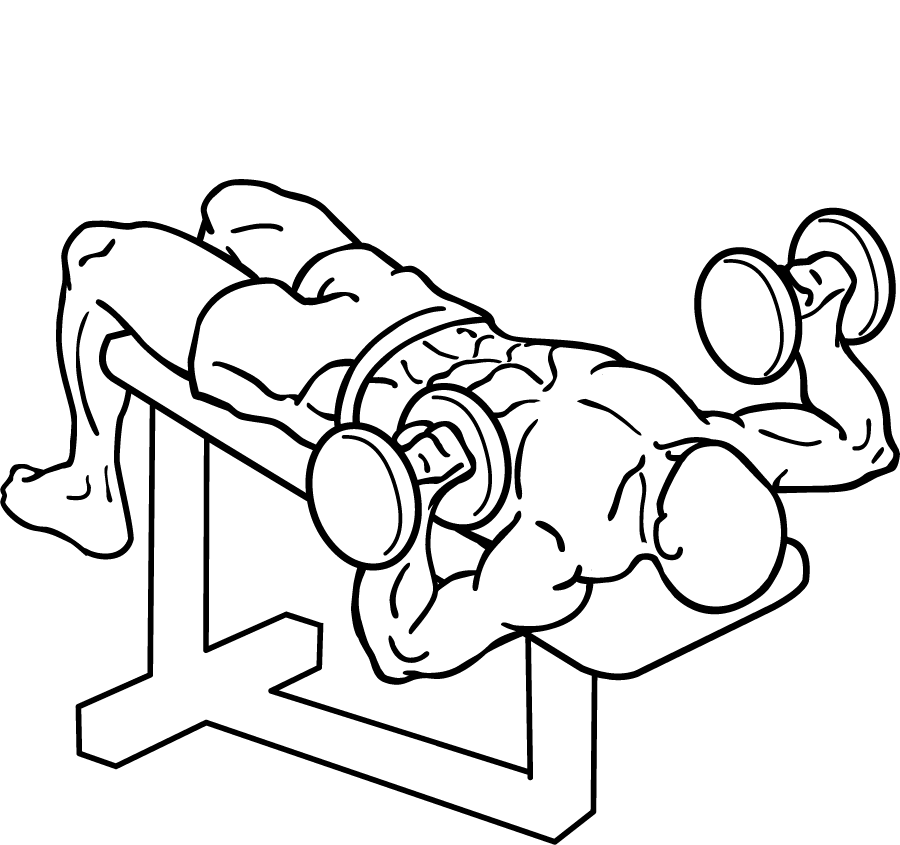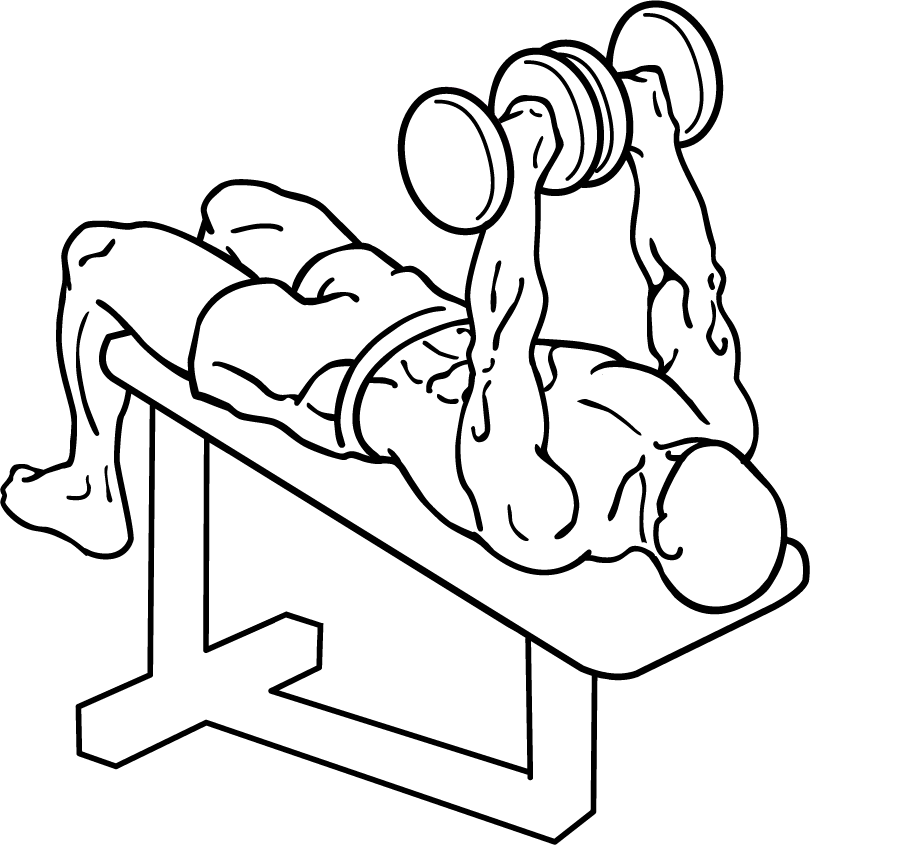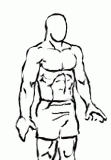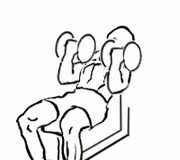Last Updated on September 30, 2014
The decline dumbbell bench press is a highly effective exercise for developing strength and muscle definition in the chest, shoulders, and triceps. This variation of the traditional dumbbell bench press is performed on a decline bench, which shifts the focus to the lower portion of the chest while still engaging the other key upper body muscles. Whether you’re an experienced lifter looking to diversify your workout routine or a beginner aiming to strengthen your upper body, the decline dumbbell bench press is a great addition to any strength-training program.
In this in-depth guide, we’ll explore the benefits of the decline dumbbell bench press, the proper technique for performing it safely and effectively, common mistakes to avoid, and how to incorporate it into your workout routine to achieve the best results.
What Is the Decline Dumbbell Bench Press?
The decline dumbbell bench press is a compound exercise that involves pressing dumbbells while lying on a decline bench. The decline angle, where your head is positioned lower than your feet, places more emphasis on the lower chest (pectoralis major) than the flat or incline bench press. The movement also engages the anterior deltoids (shoulders) and triceps (back of the upper arms), making it a full upper body workout.
Unlike the traditional barbell bench press, which requires the use of a barbell, the dumbbell variation allows for a greater range of motion and helps to correct muscle imbalances since each arm works independently. The decline angle offers additional benefits by targeting parts of the chest that may be underworked in other exercises.
Muscles Worked During Decline Dumbbell Bench Press
This exercise effectively targets multiple muscle groups, making it a powerful movement for building upper body strength. Here’s a breakdown of the muscles worked:
- Pectoralis Major (Chest): The primary muscle worked in the decline dumbbell bench press is the lower portion of the chest. The decline angle shifts more focus here than the upper or mid-chest, helping to create a fuller, more balanced chest.
- Triceps Brachii (Arms): The triceps assist in extending the arms during the pressing movement, helping you push the dumbbells away from your chest.
- Anterior Deltoids (Shoulders): The front part of your shoulders is engaged to stabilize the movement and assist in pressing the weight.
- Stabilizer Muscles: Since you’re using dumbbells instead of a barbell, various stabilizer muscles in the arms, shoulders, and core are engaged to help maintain balance and control during the movement.
Benefits of the Decline Dumbbell Bench Press
Incorporating the decline dumbbell bench press into your workout routine offers a range of benefits that go beyond simple strength gains. Some of the key advantages include:
- Targeted Lower Chest Development: The decline bench angle emphasizes the lower portion of your chest, helping you develop a more defined and balanced chest. This is particularly beneficial for lifters who feel their lower chest is underdeveloped compared to their upper chest.
- Improved Muscle Symmetry: Since dumbbells are used in this exercise, each arm works independently, which helps correct any muscle imbalances that may occur when using a barbell. This ensures that both sides of your chest and arms are worked evenly.
- Increased Range of Motion: Dumbbells allow for a greater range of motion compared to a barbell, which can lead to more effective muscle activation and growth. This extended range of motion also makes the movement more challenging, promoting better strength development.
- Enhanced Shoulder and Triceps Strength: In addition to working the chest, the decline dumbbell bench press significantly engages the triceps and shoulders, making it a valuable exercise for overall upper body strength.
- Reduced Shoulder Strain: The decline angle puts less stress on the shoulder joints compared to the flat or incline bench press, making it a safer option for individuals with shoulder discomfort or those looking to avoid shoulder strain.
- Core Activation: While not a primary core exercise, the decline position requires your core muscles to stabilize your body, adding an extra layer of engagement for your abdominal muscles.
Proper Technique for Decline Dumbbell Bench Press
Performing the decline dumbbell bench press with proper form is essential for maximizing its effectiveness and minimizing the risk of injury. Follow these steps to ensure you’re executing the movement correctly:
- Set up the decline bench: Start by adjusting the decline bench to an angle of 15 to 30 degrees. Make sure the bench is stable and that your feet are securely placed under the footpads for support.
- Grab the dumbbells: Select an appropriate weight and hold a dumbbell in each hand with a neutral grip. Sit on the bench and then carefully lean back into the decline position, keeping the dumbbells close to your chest.
- Position the dumbbells: Once you’re lying on the bench, raise the dumbbells above your chest with your palms facing forward. Your arms should be fully extended, but do not lock your elbows. This is your starting position.
- Lower the dumbbells: Slowly and with control, lower the dumbbells down toward either side of your lower chest. Keep your elbows at a slight angle to avoid flaring them out too much, as this can put unnecessary strain on your shoulders.
- Pause at the bottom: When the dumbbells reach the level of your lower chest, pause briefly. This pause helps ensure that your muscles are fully engaged, and it prevents you from using momentum to lift the weights.
- Press the dumbbells back up: Push the dumbbells back up to the starting position by pressing through your chest muscles. Keep the movement slow and controlled, and avoid locking out your elbows at the top of the press.
- Repeat: Perform the desired number of repetitions. A common set and rep range for muscle building is 3 to 4 sets of 8 to 12 reps.
Common Mistakes to Avoid
To get the most out of the decline dumbbell bench press and avoid potential injuries, it’s important to avoid the following common mistakes:
- Flaring Your Elbows: One of the most frequent mistakes is allowing your elbows to flare out too far during the press. This can place unnecessary stress on the shoulders and reduce the engagement of the chest muscles. Keep your elbows at a 45-degree angle from your body.
- Using Too Much Weight: Lifting too heavy can lead to improper form and increase the risk of injury. It’s better to start with lighter weights, focus on perfecting your form, and gradually increase the weight as you build strength.
- Not Controlling the Movement: Lowering the dumbbells too quickly or bouncing them off your chest reduces muscle activation and increases the risk of injury. Focus on a slow, controlled descent to maximize muscle engagement.
- Locking Your Elbows: Locking your elbows at the top of the movement shifts the tension away from your chest and triceps, which can reduce the effectiveness of the exercise. Keep a slight bend in your elbows throughout the movement.
- Arching Your Back Excessively: While a slight arch in the lower back is natural, excessive arching can strain your spine. Make sure to engage your core and maintain a neutral spine throughout the exercise.
Variations of the Decline Dumbbell Bench Press
Once you’ve mastered the standard decline dumbbell bench press, you can try these variations to keep your workouts challenging and target your muscles from different angles:
- Decline Barbell Bench Press: Switch to a barbell instead of dumbbells to lift heavier weights. This variation is ideal for those looking to increase overall strength while still targeting the lower chest.
- Single-Arm Decline Dumbbell Press: Perform the movement with one arm at a time. This variation helps improve balance and forces each side of your body to work independently, correcting any muscle imbalances.
- Decline Dumbbell Fly: Instead of pressing the dumbbells, perform a fly movement by keeping your arms slightly bent and lowering the dumbbells out to your sides. This variation focuses more on stretching and isolating the chest muscles.
- Paused Decline Dumbbell Press: Add a pause at the bottom of the movement to increase time under tension. This variation challenges your muscles to stay engaged for a longer period, promoting better strength gains.
How to Incorporate the Decline Dumbbell Bench Press into Your Workout Routine
The decline dumbbell bench press is a versatile exercise that can be integrated into a variety of upper body and chest-focused workouts. Here are some tips on how to include it in your routine:
- Frequency: Include the decline dumbbell bench press 1 to 2 times per week in your upper body or chest workouts, depending on your training split.
- Reps and Sets: For muscle growth, aim for 3 to 4 sets of 8 to 12 reps. If you’re focusing on strength, opt for 4 to 5 sets of 4 to 6 reps with heavier weights.
- Pair with Complementary Exercises: Combine the decline dumbbell bench press with other chest exercises such as the incline press, flat bench press, or chest flys for a balanced chest workout that targets all areas of the pectorals.
- Rest Between Sets: Allow 1 to 2 minutes of rest between sets to ensure that you maintain good form and give your muscles time to recover.
Final Tips for Success
- Start with a Warm-Up: Always warm up before performing the decline dumbbell bench press to prepare your muscles and joints for the workout. Perform some light cardio and dynamic stretches, followed by a few sets of lighter weights to get your chest, shoulders, and triceps ready.
- Focus on Form Over Weight: It’s tempting to increase the weight quickly, but proper form is key to getting the most out of this exercise. Ensure you are controlling the movement throughout each rep and not using momentum to lift the weights. As your form improves, you can gradually increase the weight.
- Consistency Is Key: To see improvements in chest strength and definition, consistency is crucial. Make sure to incorporate the decline dumbbell bench press into your weekly routine and track your progress. Over time, you will notice significant gains in both strength and muscle size.
- Use a Spotter When Needed: If you’re lifting heavier weights or pushing your limits, it’s always a good idea to have a spotter to assist in case you struggle with the last few reps. A spotter can also help ensure you maintain proper form throughout the exercise.
- Don’t Neglect Other Chest Exercises: While the decline dumbbell bench press is excellent for targeting the lower chest, it’s important to incorporate other exercises, such as the incline press, flat bench press, and chest flys, to target the entire chest. A balanced approach to chest training will help you develop a well-rounded and powerful upper body.
Conclusion
The decline dumbbell bench press is a fantastic exercise for building strength and muscle mass in the chest, shoulders, and triceps. By focusing on proper technique, controlling the movement, and progressively challenging yourself, you can see significant improvements in your upper body strength and muscle definition. Whether you’re new to strength training or an experienced lifter, this exercise should be a staple in your routine for targeting the lower chest and supporting overall upper body development.
As with any exercise, the key to success is consistency and progression. Make the decline dumbbell bench press a regular part of your workout routine, and over time, you’ll notice impressive gains in strength and muscle tone, giving you a stronger, more balanced physique.








